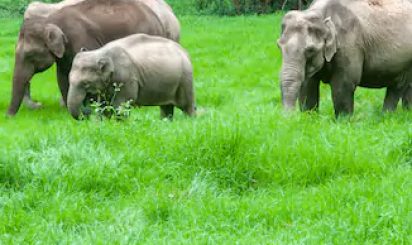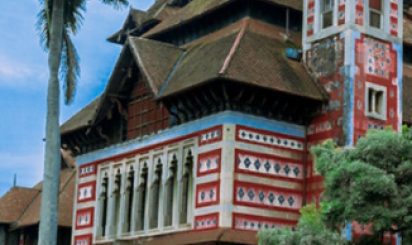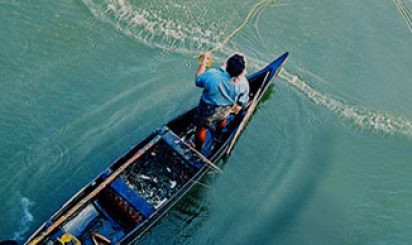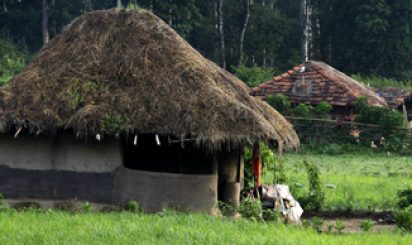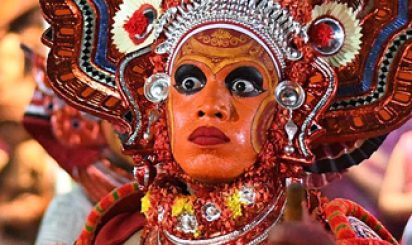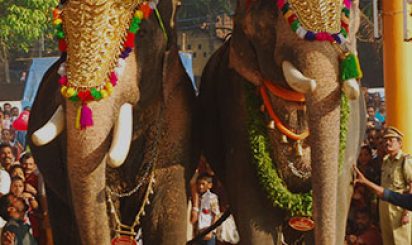
Cherai
- Cherai
- Geography
- History
- People & Culture
- Flora and Fauna
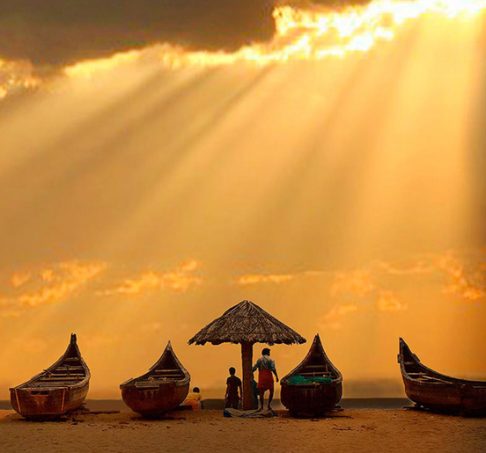 Blessed with a unique blend of sea and backwaters, Cherai is an exotic mixture of nature and culture at its best. With the beautiful Periyar River to the east, and the inviting waters of the Arabian Sea to the west, Cherai has everything that a holidaymaker would desire. It has acres of whispering green coconut corridors, a glorious long shoreline of secluded golden beaches, warm sunshine and sea, laced with tranquil stretches of winding scenic backwater where local fishermen expertly employ their traditional Chinese fishing nets. Cherai boasts of several historic temples, churches and mosques, which attract people of differing faith who have lived in communal harmony for centuries. It also hosts a series of annual religious festivals bursting with colour and vibrancy, which do not fail to fascinate and capture the imaginations of visitors.
Blessed with a unique blend of sea and backwaters, Cherai is an exotic mixture of nature and culture at its best. With the beautiful Periyar River to the east, and the inviting waters of the Arabian Sea to the west, Cherai has everything that a holidaymaker would desire. It has acres of whispering green coconut corridors, a glorious long shoreline of secluded golden beaches, warm sunshine and sea, laced with tranquil stretches of winding scenic backwater where local fishermen expertly employ their traditional Chinese fishing nets. Cherai boasts of several historic temples, churches and mosques, which attract people of differing faith who have lived in communal harmony for centuries. It also hosts a series of annual religious festivals bursting with colour and vibrancy, which do not fail to fascinate and capture the imaginations of visitors.“Once a tourist to Cherai, always a tourist to Cherai”
 Blessed with a unique blend of sea and backwaters, Cherai is an exotic mixture of nature and culture at its best. With the beautiful Periyar River to the east, and the inviting waters of the Arabian Sea to the west, Cherai has everything that a holidaymaker would desire. It has acres of whispering green coconut corridors, a glorious long shoreline of secluded golden beaches, warm sunshine and sea, laced with tranquil stretches of winding scenic backwater where local fishermen expertly employ their traditional Chinese fishing nets. Cherai boasts of several historic temples, churches and mosques, which attract people of differing faith who have lived in communal harmony for centuries. It also hosts a series of annual religious festivals bursting with colour and vibrancy, which do not fail to fascinate and capture the imaginations of visitors.
Blessed with a unique blend of sea and backwaters, Cherai is an exotic mixture of nature and culture at its best. With the beautiful Periyar River to the east, and the inviting waters of the Arabian Sea to the west, Cherai has everything that a holidaymaker would desire. It has acres of whispering green coconut corridors, a glorious long shoreline of secluded golden beaches, warm sunshine and sea, laced with tranquil stretches of winding scenic backwater where local fishermen expertly employ their traditional Chinese fishing nets. Cherai boasts of several historic temples, churches and mosques, which attract people of differing faith who have lived in communal harmony for centuries. It also hosts a series of annual religious festivals bursting with colour and vibrancy, which do not fail to fascinate and capture the imaginations of visitors.Perhaps the most endearing aspect of a holiday to Cherai is the striking friendliness of the local people who are warm, welcoming and helpful. This, combined with the wonderful climate and the many enchanting attractions waiting to be explored, surely make ‘God’s own beach’ a very special to visit. It is the perfect destination for anyone who wishes to escape the hustle and bustle of urban life and relax in a naturally beautiful and culturally rich environment.
“Once a tourist to Cherai, always a tourist to Cherai”
 Little is known for certain about Cherai’s early history. Due to unprecedented flooding of the River Periyar in 1341 the backwaters burst through the narrow sand banks, which separated them from the sea at Cochin making a new outlet. It was at this time that the island of Vypeen is said to have originated, providing a home to early inhabitants who made their living from fishing.
Little is known for certain about Cherai’s early history. Due to unprecedented flooding of the River Periyar in 1341 the backwaters burst through the narrow sand banks, which separated them from the sea at Cochin making a new outlet. It was at this time that the island of Vypeen is said to have originated, providing a home to early inhabitants who made their living from fishing.Cherai first stepped into the limelight of history after the Portuguese arrived on the Kerala coast in 1498. At this time a powerful sovereign, the Zamorin, ruled over almost all the chieftains of Kerala, including the Raja of Cochin who was his vassal. Zamorin gave a warm welcome to the Portuguese and allowed them to indulge in the spice trade, although the ultimate aim of the Portuguese was to monopolise this lucrative trade. The Zamorin enjoyed a strong alliance with the Arab spice traders and he refused to grant the Portuguese a monopoly of this trade. Due to uncertainty in the spice trade the Portuguese made a secrete alliance with the Raja of Cochin. This incident forced the Zamorin to expel the Portuguese from Calicut waters, who were then welcomed by the Cochin Raja as potential opponents of his rival, the Zamorin. The Portuguese lavished gifts on the Raja and in return were granted an exclusive trading agreement. Infuriated by this treaty, the Zamorin inflicted a crushing defeat on the Raja of Cochin who fled to Vypeen (Elankunnapuzha). However, on September 20th 1503 the Cochin Raja (Perumpadappu Swarupam) was reinstated by the Portuguese army, led by General Albuquerque, During this time, pirates at Pallipuram were creating a great deal of trouble for local merchants and their goods. In order to safeguard the territory, and at the same time to the life and property of merchants, the Raja of Cochin permitted the Portuguese to construct a Fort at Pallipuram and in 1503 the Portuguese built the hexagonal, three-storied structure (Aya ktta or Azhi Kotta) which acted as an out-post to protect the ancient port of Muziris. Pallipuram and Muziris were developed by the Portuguese as “Twin Cities” and in 1507 they built the Pallipuram Ave Mary Church In 1574 they established the famous “Vaipakkotta” Seminary and Jesuit Monastery, whilst in 1579 they started the first Printing Press in Kerala in the adjoining seminary.
With the arrival of the Dutch, the Portuguese missionaries were forced to shift the Printing Press from “Vaipakkotta” Seminary and Jesuit Monastery to Chennamangalam.On February 15th 1661 the Dutch Admiral Vander Meyden made an alliance with the Zamorin, which eventually resulted in the expulsion of the Portuguese and the capturing of the Fort in Pallipuram. Although the Protestant Dutch slaughtered local Catholics, they did not destroy Pallipuram Church and amazingly they even built a chapel for the church. In the beginning of 1728 the seminary was converted to a leprosy asylum.
In 1789 the Maharaja of Travancore, fearing attack by the forces of the Tippu Sultan of Mysore, negotiated with the Dutch to purchase Pallipuram Fort and the neighbouring area. The Dutch sold the property to the Maharaja of Travancore on July 31st for 3 lakh (300,000) rupees. The treaty was signed by the Divan Raja Kesavadas and Dutch Governor, Gerard Van Angel Beck. The leprosy asylum, certain buildings, and 9 acres of land were not included in the sale and continued to be owned by the Dutch. After the sale, Travancore and Cochin engaged in many territorial disputes. Unlike the Portuguese, the Dutch, for reasons of self interest, made no attempt to convert Hindus to Christianity, and although they showed little interest in education, they did revive trade and also began harvesting salt in Cherai. The Dutch were far less corrupt than the Portuguese and their administration was fairer.
On October 20th 1795, the Dutch were defeated by the British Army under Major Petty, and Dutch properties in Pallipuram came under British authority. This area, was called “British”, remained under the direct administration of the British government until India gained independence on August 15th 1947. As agreed by the Dutch and the British, the leprosy centre remained in existence until 1921.
In 1949 Cochin and Travancore were combined and administered from Madras until November 1st 1956. The boundaries of the present state of Kerala were then established and in 1957 the Kerala people democratically elected the first communist government in the world. On December 19th 1963, Pallipuram Panchayat was reconstituted by making Kuzhupilly an independent Panchayat and merging it with Munambam.
 Blessed with a unique blend of sea and backwaters, Cherai is an exotic mixture of nature and culture at its best. With the beautiful Periyar River to the east, and the inviting waters of the Arabian Sea to the west, Cherai has everything that a holidaymaker would desire. It has acres of whispering green coconut corridors, a glorious long shoreline of secluded golden beaches, warm sunshine and sea, laced with tranquil stretches of winding scenic backwater where local fishermen expertly employ their traditional Chinese fishing nets. Cherai boasts of several historic temples, churches and mosques, which attract people of differing faith who have lived in communal harmony for centuries. It also hosts a series of annual religious festivals bursting with colour and vibrancy, which do not fail to fascinate and capture the imaginations of visitors.
Blessed with a unique blend of sea and backwaters, Cherai is an exotic mixture of nature and culture at its best. With the beautiful Periyar River to the east, and the inviting waters of the Arabian Sea to the west, Cherai has everything that a holidaymaker would desire. It has acres of whispering green coconut corridors, a glorious long shoreline of secluded golden beaches, warm sunshine and sea, laced with tranquil stretches of winding scenic backwater where local fishermen expertly employ their traditional Chinese fishing nets. Cherai boasts of several historic temples, churches and mosques, which attract people of differing faith who have lived in communal harmony for centuries. It also hosts a series of annual religious festivals bursting with colour and vibrancy, which do not fail to fascinate and capture the imaginations of visitors.Perhaps the most endearing aspect of a holiday to Cherai is the striking friendliness of the local people who are warm, welcoming and helpful. This, combined with the wonderful climate and the many enchanting attractions waiting to be explored, surely make ‘God’s own beach’ a very special to visit. It is the perfect destination for anyone who wishes to escape the hustle and bustle of urban life and relax in a naturally beautiful and culturally rich environment.
“Once a tourist to Cherai, always a tourist to Cherai”
 Blessed with a unique blend of sea and backwaters, Cherai is an exotic mixture of nature and culture at its best. With the beautiful Periyar River to the east, and the inviting waters of the Arabian Sea to the west, Cherai has everything that a holidaymaker would desire. It has acres of whispering green coconut corridors, a glorious long shoreline of secluded golden beaches, warm sunshine and sea, laced with tranquil stretches of winding scenic backwater where local fishermen expertly employ their traditional Chinese fishing nets. Cherai boasts of several historic temples, churches and mosques, which attract people of differing faith who have lived in communal harmony for centuries. It also hosts a series of annual religious festivals bursting with colour and vibrancy, which do not fail to fascinate and capture the imaginations of visitors.
Blessed with a unique blend of sea and backwaters, Cherai is an exotic mixture of nature and culture at its best. With the beautiful Periyar River to the east, and the inviting waters of the Arabian Sea to the west, Cherai has everything that a holidaymaker would desire. It has acres of whispering green coconut corridors, a glorious long shoreline of secluded golden beaches, warm sunshine and sea, laced with tranquil stretches of winding scenic backwater where local fishermen expertly employ their traditional Chinese fishing nets. Cherai boasts of several historic temples, churches and mosques, which attract people of differing faith who have lived in communal harmony for centuries. It also hosts a series of annual religious festivals bursting with colour and vibrancy, which do not fail to fascinate and capture the imaginations of visitors.Perhaps the most endearing aspect of a holiday to Cherai is the striking friendliness of the local people who are warm, welcoming and helpful. This, combined with the wonderful climate and the many enchanting attractions waiting to be explored, surely make ‘God’s own beach’ a very special to visit. It is the perfect destination for anyone who wishes to escape the hustle and bustle of urban life and relax in a naturally beautiful and culturally rich environment.
